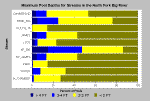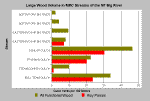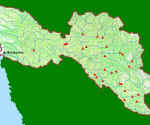Bibliography Background About KRIS
Hypothesis #3: Reduced large wood supply has contributed to the loss of pool habitat and the decline of coho salmon in the Big River basin.
Support for the Hypothesis from the Literature
Stillwater Sciences (1997) studied the history of large wood removal in Mendocino County for the Louisiana Pacific Corporation as part their Sustained Yield Plan. They actually advanced this hypothesis as part of their report:
Large wood is an extremely important element in helping create and maintain fish habitat diversity, especially in coastal streams (see the Big Wood background page). Among many fish habitat creating and maintaining roles, large wood ameliorates excess sediment supply (Kelley et al. 1995), and may also help keep streams cool by forcing more flow into shallow ground water (Poole and Berman 1999). The function of large wood apparently most fundamental for coho salmon, however, is pool formation associated with bed scour. The addition of large wood to streams has been shown to increase pool frequency and coho salmon production (Cedarholm et al., 1997). An analysis of habitat typing data and remnant distribution of coho salmon in the Ten Mile River basin revealed that the streams where coho persist could be predicted by levels of scour pool habitat formed by large wood (Mangelsdorf and Clyde 2000)."One of the working hypotheses concerning coho salmon ecology and management in Mendocino County streams is that large woody debris (LWD), and the rearing habitat that it provides, may currently be the most important factor limiting coho populations. The well-documented role of LWD in coho salmon ecology, combined with the observation that the recent decline of coho salmon in California appears to be somewhat coincident with large-scale LWD removal programs led quite naturally to this hypothesis."
O'Connor and Ziemer (1989) found that large wood supply in the North Fork Caspar Creek reflected timber harvest activities from 100 years prior. The average density of large wood in the bank-full channel was measured at 339 m3/ha, or 24.3 m3/100m. This density, in a second-growth channel, is 21% of the average reported for twelve reaches in Redwood National Park, and 47% of the average reported for twenty-eight pre-harvest streams in coastal Washington (Shott 2000). A predominance of fir and alder in the North Fork Caspar Creek was explained as the result of early succession of harvested riparian zones, and the authors suggested that large wood supply may actually decrease due to a centuries-long delay in recruitment of the long-lasting redwood. The authors noted that only 7% of all large wood in the bank-full channel was associated with pool habitat, but redwood root-wads left after harvesting were conspicuously important in that function.
Surfleet and Ziemer (1996) returned to the North Fork Caspar Creek after 60% of that basin was clear-cut around riparian buffers in 1992, and comparatively studied the South Fork Caspar Creek where 60% of the basin was selectively cut without riparian buffers, and where stream-cleaning activities occurred twenty five years earlier. The study supports the importance of riparian buffer strips for providing the recruitment of large wood to streams, but further documents the wood supply deficit from historic logging and stream cleaning. See the Stream Clearance background page to find out why large wood was removed from streams as part of early restoration efforts.
Support from the KRIS Big River Database
Large wood removal in the Big River is documented by Stillwater Sciences (1997). CDF provided for use in KRIS Maps the wood removal map layer prepared by Stillwater Sciences. In addition, more than twenty California Department of Fish and Game stream surveys and reports (1959-1987), which are available in the KRIS Bibliography, prescribe the removal of log jams which were perceived barriers to fish. Historical information in KRIS also documents extensive splash damming of the Big River, which would have a significant effect on depletion of large wood and simplification of stream channels.
Existing large wood supplies within streams of the Big River area are very low, as recorded by Mendocino Redwood Company surveys of 28 streams in the Big River basin, and CDFG surveys of Hare Creek (1999) and Caspar Creek (1999). MRC surveyed reaches of the Mainstem, North Fork, and South Fork of the Big River and found they had no key pieces of large wood or wood which could individually contribute to pool formation. Moderate-sized tributaries, such Two Log Creek, East Branch of the North Fork, Upper Big River, Daugherty Creek, and Ramon Creek, each averaged less than 5 cubic yards/100 meters of wood in the key piece category. Although the CDFG wood data does not allow for the calculation of wood volume densities, the inventory results indicate that wood supply may be similarly low in Hare Creek and Caspar Creek. Hare Creek was subject to wood removal in the 1960s, and the wood supply in Hare Creek is conspicuously lower than that in Caspar Creek.
Habitat data for the Big River basin has not been analyzed with regard to scour pool frequency or wood-formed pool frequency, but the readily available attributes of maximum pool depth and overall pool frequency show that pool habitat in most streams in the area have pool habitat that would be rated poor or fair at best.
 This image, from the KRIS Big River map project, shows the history of wood removal projects in Two Log Creek and the North Fork Big River, as was ascertained by Stillwater Sciences' review of available records. The map also shows the location of historic splash dams. Although the wood removal record is incomplete, the map shows extensive coverage of such activities in this portion of the Big River area, and documents where two separate rounds of wood removal occurred.
This image, from the KRIS Big River map project, shows the history of wood removal projects in Two Log Creek and the North Fork Big River, as was ascertained by Stillwater Sciences' review of available records. The map also shows the location of historic splash dams. Although the wood removal record is incomplete, the map shows extensive coverage of such activities in this portion of the Big River area, and documents where two separate rounds of wood removal occurred.
 This map shows streams in the North Fork Big River that have been habitat typed by CDFG. The colors correspond to summary values for pool frequency (percent pool habitat by length). Surveyed stream reaches downstream of splash damming and where wood removal occurred have fewer than 20% pool habitat by length.
This map shows streams in the North Fork Big River that have been habitat typed by CDFG. The colors correspond to summary values for pool frequency (percent pool habitat by length). Surveyed stream reaches downstream of splash damming and where wood removal occurred have fewer than 20% pool habitat by length.
 The habitat types by unit from which the summary data above is shown at left. Habitat types are grouped by color into the basic or level 1 types: pools, riffles, and runs. The relative frequency of pool habitat is indicated by the occurrence of blue.
The habitat types by unit from which the summary data above is shown at left. Habitat types are grouped by color into the basic or level 1 types: pools, riffles, and runs. The relative frequency of pool habitat is indicated by the occurrence of blue.
 This map image shows individual habitat units in categories of maximum depth. The lack of green units in Two Log Creek, Chamberlain Creek, James Creek, and the East Branch of the North Fork Big River illustrates the shortage of deep pools in these tributaries, and a potential limiting factor for coho salmon. Larger streams, such as the North Fork Big River, will naturally have deeper pools regardless of large wood availability.
This map image shows individual habitat units in categories of maximum depth. The lack of green units in Two Log Creek, Chamberlain Creek, James Creek, and the East Branch of the North Fork Big River illustrates the shortage of deep pools in these tributaries, and a potential limiting factor for coho salmon. Larger streams, such as the North Fork Big River, will naturally have deeper pools regardless of large wood availability.
 The chart at left shows the relative proportion of pools in surveyed reaches of the North Fork Big River sub-basin, according to maximum pool depth. Except for the larger North Fork Big River itself, no stream had greater than 25% of pools with depths exceeding 3 feet.
The chart at left shows the relative proportion of pools in surveyed reaches of the North Fork Big River sub-basin, according to maximum pool depth. Except for the larger North Fork Big River itself, no stream had greater than 25% of pools with depths exceeding 3 feet.
 This chart shows results of MRC large wood surveys in the North Fork Big River sub-basin by volume. The North Fork Big River and the East Branch Big River had less than 10 cubic yards of wood per 100 meters. The four reaches shown at the bottom of the chart are smaller and steeper headwater streams not subject to wood removal and probably not accessible to anadromous fish.
This chart shows results of MRC large wood surveys in the North Fork Big River sub-basin by volume. The North Fork Big River and the East Branch Big River had less than 10 cubic yards of wood per 100 meters. The four reaches shown at the bottom of the chart are smaller and steeper headwater streams not subject to wood removal and probably not accessible to anadromous fish.
 The image at left, from the KRIS Big River Map project, shows the location of splash dams on the Big River. These dams were used to store water which would be released during rainfall to couple with natural flow peaks and float logs to tide water. Upstream dams were tripped as early as 4 A.M. to start logs on their journey from the headwaters. Dams downstream would be tripped as the logs from upstream passed. The over-all effect of these man-made debris torrents on stream channels in the Big River was to scour all big wood as well as cobble and gravel.
The image at left, from the KRIS Big River Map project, shows the location of splash dams on the Big River. These dams were used to store water which would be released during rainfall to couple with natural flow peaks and float logs to tide water. Upstream dams were tripped as early as 4 A.M. to start logs on their journey from the headwaters. Dams downstream would be tripped as the logs from upstream passed. The over-all effect of these man-made debris torrents on stream channels in the Big River was to scour all big wood as well as cobble and gravel.
Alternative Hypothesis
Large wood supply is not an appreciable factor in the decline of coho salmon abundance.
This alternative hypothesis points to the other factors which may reduce coho salmon abundance. Data on coho salmon presence or abundance in relation to changes in wood supply should be analyzed in the context of other factors. Additional support for this alternative could come from the supporting evidence for Hypothesis #2 (i.e., Sedimentation may be such a dominant limiting factor that large wood could not compensate for reduced pool volumes as a result of aggradation). High water temperature could also be a competing mechanism for coho decline, as advanced in Hypothesis #3. Ultimately, support for this alternative hypothesis must come from demonstration that coho salmon can persist in abundance in a variety of natural streams without large wood.
Methods to Support or Refute the Hypotheses
Studies could be conducted wherein large wood could be added to streams with low numbers of coho to see if juvenile carrying capacity might be increased. Experiments are already being conducted on nearby Jackson Demonstration State Forest by the California Department of Fish and Game (Collins, 1999) to determine whether pool frequency and depth can be improved on Parlin Creek through the addition of large wood to the stream.
Existing habitat data from CDFG could be analyzed with respect to scour pool and large-wood formed pool frequency. These attributes in conjunction with better information on coho salmon populations, could be used to examine the relationship between large wood, pool habitat, and coho salmon persistence or decline.
References
Cedarholm, C.J., R.E. Bilby, P.A. Bisson, T.W. Bumstead, B.R. Fransen, W.J. Scarlett and J.W. Ward. 1997. Response of Juvenile Coho Salmon and Steelhead to Placement of Large Woody Debris in a Coastal Washington Stream. North American Journal of Fisheries Management. 17:947-963.
Collins, B.W. 1999. Parlin Creek Large Woody Debris Placement Project. Jackson Demonstration State Forest Newsletter. Volume 51 (Spring/Summer). CA Department of Forestry and Fire Protection, Mendocino Ranger District.
Holman, G. and W. Evans. 1964. Noyo River Stream Clearance Projects. California Department of Fish and Game. 12 p.
Kelly, E.A., A. MacDonald, T. Tally and N.J. Merrit. 1995. Effects of Large Organic Debris on Channel Morphology and Sediment Storage in Selected Tributaries of Redwood Creek, Northwestern, California. U.S. Geologic Survey Professional Paper 1454-P, Menlo Park, CA. 29 p.
Mangelsdorf, A. and L. Clyde. 2000. Ten Mile Chapter (Chapter 4) excerpt from Draft Assessment of aquatic conditions in the Mendocino Coast Hydrologic Unit. California Regional Water Resources Control Board. North Coast Region. Santa Rosa, CA. 120 pp.
O'Connor, M.D., and R.R. Ziemer. 1989. Coarse woody debris ecology in a second-growth Sequoia sempervirens forest stream. Proceedings of the California Riparian Systems Conference: protection, management, and restoration for the 1990's. September 1988, Davis, California. U.S. Department of Agriculture, Pacific Southwest Forest and Range Experiment Station (PSW): p. 165-171. Gen. Tech. Rep. PSW-110.
Surfleet, C.G., and R.R. Ziemer. 1996. Effects of forest harvesting on large organic debris in coastal streams. Pages 134-136 in: LeBlanc, John, ed., Conference on Coast Redwood Forest Ecology and Management, 1996 June 18-20, Humboldt State Univ., Arcata, CA.
Schuett-Hames, D., A.E. Pleus, J. Ward, M. Fox, and J. Light. 1999.</a> TFW Monitoring Program method manual for the large woody debris survey. Prepared for the Washington State Dept. of Natural Resources under the Timber, Fish, and Wildlife Agreement. TFW-AM9-99-004. DNR #106. 66 pp.
Poole, G.C., and C.H. Berman. 2000. Pathways of human influence on water temperature dynamics in stream channels. Environmental Management. 20 pp.
Shott, Eric. 2000. Changes in Quantity and Characteristics of Large Woody Debris in Streams of the Olympic Peninsula, Washington (1982-1993). Proceedings of the Eighteenth Annual Salmonid Restoration Federation Conference.
Stillwater Sciences. 1997. A review of coho salmon life history to assess potentially limiting factors and the implications of historical removal of large woody debris in coastal Mendocino County. Prepared by Stillwater Sciences, Berkeley CA for Louisiana-Pacific Corporation, Wildlife and Fisheries Science Group, Forest Resources & Fiber Procurement Division. May 1997. 55 pp